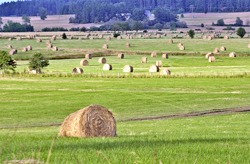The San Juan County Council has scheduled a public hearing on an ordinance to change farmland conservation rules so that current-use tax assessment benefits can be extended to more properties for longer periods of time.
A public hearing to amend Section 16.50.265 of the San Juan County Code regarding farm and conservation land will be held May 20 on Orcas Island, at the Eastsound Fire Station, 45 Lavender Lane, beginning at 10:15 a.m.
San Juan County Council Chairman Rick Hughes, a proponent of the change, says the 10-year limit on returning farmland to active agricultural production may not be reasonable because of the time it takes to return fallow farmland to profitable production, especially if estate planning on old family farms becomes an issue.
Hughes said his main concern is for tracts of farmland more than 20 acres “that are actually used for farming.” He said that he is not trying to protect “hobby farms” and that “there are very rigorous procedures for getting into open space programs and staying in them.”
Land used for farming can receive reduction of tax assessments below “fair market value” if the farmer meets certain criteria for profitable farming under state law. “Current use farmland” tax assessment reductions are administered by the county assessor. These reductions are not time-limited, but if active farming ends, back taxes and penalties can be imposed.
Land not used for actual farming for a period of time can receive reduced assessments from the county council if the owner meets certain criteria set by county law. It is this law that is the subject of the proposed new ordinance.
Under current county law, the land must either be returned to active farming within 10 years or the owner must enter into a conservation easement permanently prohibiting development inconsistent with agricultural use. The proposed change would extend the time limit for returning the land to active farming to 20 years.
Other criteria must be satisfied before the council can grant the assessment benefit, including that the land in question must be “sub-dividible,” that is, the area of each subject property must be equal to or greater than two times the maximum residential density of the underlying zoning district. The requirement that the land be sub-dividible would be eliminated by the proposed ordinance.
The hearing notice provides that immediately after the public hearing, the council may consider the ordinance and any amendments, and “[t]he proposed Ordinance may then be adopted with or without modifications.”




